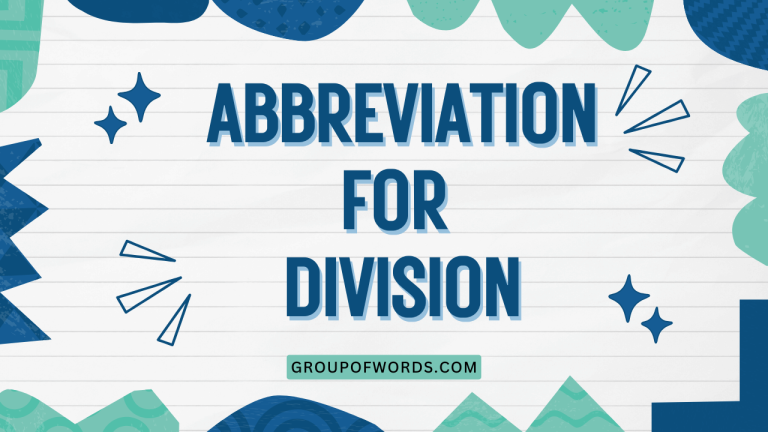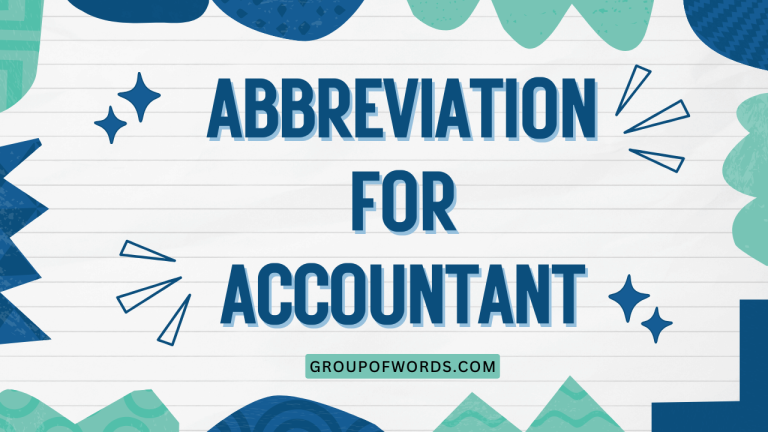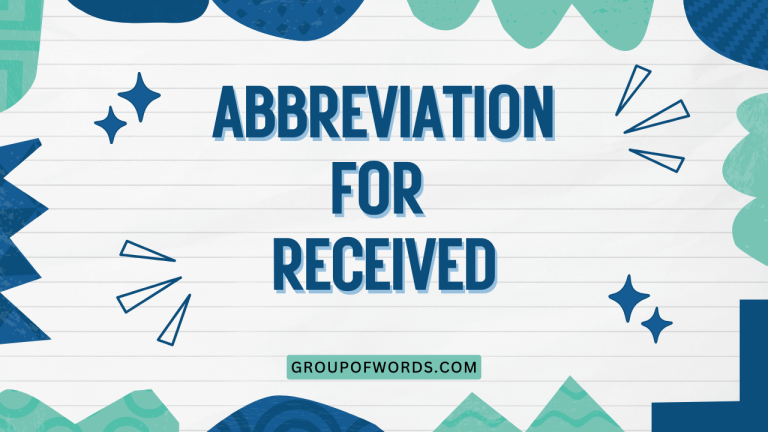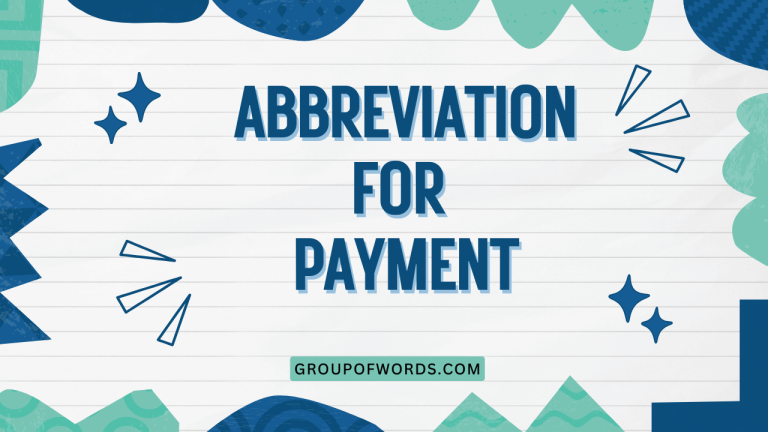Abbreviations for Consultant: A Comprehensive Guide
Understanding the correct abbreviations for “consultant” is crucial in professional communication. This article provides a detailed exploration of these abbreviations, their usage, and the contexts in which they are appropriate.
Mastering these abbreviations enhances clarity and efficiency in business writing, emails, and formal documents. This guide is designed for students, professionals, and anyone looking to improve their understanding of business English and professional terminology.
Whether you are drafting reports, sending emails, or updating your resume, this comprehensive guide will equip you with the knowledge to use abbreviations for “consultant” accurately and confidently.
Table of Contents
- Definition of Consultant and Its Abbreviations
- Structural Breakdown of Abbreviations
- Types and Categories of Consultant Abbreviations
- Examples of Consultant Abbreviations in Use
- Usage Rules for Consultant Abbreviations
- Common Mistakes When Using Consultant Abbreviations
- Practice Exercises
- Advanced Topics: Contextual Usage
- Frequently Asked Questions
- Conclusion
Definition of Consultant and Its Abbreviations
A consultant is a professional who provides expert advice to an organization or individual for a fee. Consultants have specialized knowledge in a particular area and are hired to help solve problems, improve performance, or implement new strategies. The term “consultant” is commonly abbreviated in various forms to save space and time in written communication. The most common abbreviations include “Consult.,” “Conslt.,” and “Cnsl.” Understanding these abbreviations and their proper usage is essential for maintaining professionalism and clarity in written communication.
The abbreviation “Consult.” is a shortened form of the word “Consultant,” used primarily in business and professional contexts. Its function is to denote a person or company that offers expert advice or services in a specific field.
It’s often used in job titles, business cards, and internal documents. The abbreviation “Conslt.” is less common but serves the same purpose.
Lastly, “Cnsl.” is an even shorter and less formal abbreviation, which can be used internally but should be avoided in formal or external communications.
Structural Breakdown of Abbreviations
The structural breakdown of consultant abbreviations involves understanding how the full word is shortened. “Consult.” retains the core letters of the word and ends with a period, indicating that it is an abbreviation.
“Conslt.” further reduces the word, omitting vowels to create a shorter form while still being recognizable. “Cnsl.” is the most abbreviated form, using only the consonants from the beginning and middle of the word.
Each abbreviation maintains a level of recognizability. “Consult.” is the most easily recognizable because it maintains the first part of the word and follows standard abbreviation rules.
“Conslt.” requires a slightly deeper understanding of the word’s structure to quickly recognize. “Cnsl.” relies heavily on context and is best used when the reader is already familiar with the term.
Types and Categories of Consultant Abbreviations
Consultant abbreviations can be categorized based on their level of formality and common usage. The three main categories are:
Formal Abbreviations
“Consult.” is the most formal and widely accepted abbreviation. It is suitable for professional documents, business cards, and formal emails. It clearly indicates that the person is a consultant without being overly casual.
Semi-Formal Abbreviations
“Conslt.” is a semi-formal abbreviation that can be used in internal documents and less formal correspondence. It is less common than “Consult.” but still widely understood in business settings.
Informal Abbreviations
“Cnsl.” is the most informal abbreviation and is generally reserved for internal use or very casual communication. It should be avoided in formal documents or when communicating with external parties.
Examples of Consultant Abbreviations in Use
The following tables provide examples of how consultant abbreviations are used in various contexts.
Table 1: Examples of “Consult.” in Use
This table illustrates the usage of the abbreviation “Consult.” in various professional settings, demonstrating its versatility and appropriateness for formal contexts. Each example provides a clear context in which the abbreviation is used, emphasizing its role in saving space and maintaining clarity.
| Context | Example Sentence |
|---|---|
| Job Title | John Smith, Senior Project Consult. |
| Business Card | Jane Doe, Marketing Consult. |
| Email Signature | Best regards, Alex Johnson, Consult. |
| Report Header | Prepared by: Robert Brown, Consult. |
| Project Team List | Team Members: Sarah Lee, Consult.; David Kim, Analyst |
| Internal Memo | Meeting with Consult. regarding strategy. |
| Contract Document | The Consult. will provide services as outlined. |
| LinkedIn Profile | Experienced IT Consult. seeking new opportunities. |
| Company Directory | Contact: Emily White, Consult. |
| Resume | Position: Management Consult. at ABC Corp. |
| Project Plan | Phase 1: Consult. review and recommendations. |
| Client Communication | Please direct your questions to our Consult. team. |
| Presentation Slide | Speaker: Michael Green, Consult. |
| Legal Document | The Consult.’s responsibilities are detailed in Appendix A. |
| Training Material | Expertise provided by external Consult. |
| Website Bio | Our team includes seasoned Consult. in various fields. |
| Press Release | Company hires new senior Consult. |
| Meeting Agenda | Item 3: Discussion with Finance Consult. |
| Performance Review | Feedback from HR Consult. |
| Budget Proposal | Allocation for external Consult. services. |
| Internal Newsletter | Welcome to our new strategy Consult. |
| Project Update | Recent insights from our data Consult. |
| Compliance Report | Reviewed by legal Consult. |
| Board Meeting Minutes | Presentation by management Consult. |
| Vendor Agreement | Terms of engagement for the Consult. are outlined. |
| Risk Assessment | Analysis provided by risk management Consult. |
| Sales Proposal | Expertise of our sales Consult. team. |
| Marketing Campaign | Strategy developed by marketing Consult. |
Table 2: Examples of “Conslt.” in Use
This table showcases the application of the abbreviation “Conslt.” in contexts that are slightly less formal, yet still professional. It’s often found in internal communications or documents where a high level of formality is not strictly required.
The examples demonstrate how “Conslt.” can be used effectively to convey the role of a consultant without being overly verbose.
| Context | Example Sentence |
|---|---|
| Internal Project Documents | Contact the Conslt. for further details. |
| Email (Internal) | Meeting with Conslt. scheduled for next week. |
| Team Meeting Notes | Conslt. to present findings next session. |
| Informal Reports | Analysis by external Conslt. |
| Internal Communication Platform | Discuss project updates with Conslt. today. |
| Employee Directory (Internal) | Jane Smith, HR Conslt. |
| Project Timeline | Conslt. review due by Friday. |
| Progress Report | Feedback from Conslt. implemented. |
| Internal Training Material | Guidance from expert Conslt. |
| Company Wiki | Information provided by management Conslt. |
| Internal Blog Post | Insights from our finance Conslt. |
| Team Chat | Ask the Conslt. about the new strategy. |
| Department Newsletter | Welcome our new IT Conslt. |
| Internal Survey | Feedback from our marketing Conslt. |
| Project Kickoff Meeting | Introduction of the lead Conslt. |
| Internal Presentation | Findings by the data Conslt. team. |
| Company Intranet | Resources provided by the legal Conslt. |
| Internal Audit Report | Reviewed by the risk Conslt. |
| Team Calendar | Appointment with the sales Conslt. |
| Management Briefing | Updates from the strategy Conslt. |
| Internal Policy Document | Guidance from compliance Conslt. |
| Staff Handbook | Contact information for the HR Conslt. |
| Internal Job Posting | Seeking a part-time Conslt. for project support. |
| Employee Onboarding | Introduction to the team’s Conslt. |
| Internal Newsletter | Spotlight on our latest consulting Conslt. |
Table 3: Examples of “Cnsl.” in Use
This table illustrates the usage of “Cnsl.” which is the most informal of the three abbreviations. It’s typically used in very casual, internal communications where brevity is prioritized.
However, it should be used cautiously, as it may not be universally understood outside of specific team or company contexts. The examples show how “Cnsl.” can be used within a close-knit team that understands the shorthand.
| Context | Example Sentence |
|---|---|
| Quick Internal Messages | Ask Cnsl. about the deadline. |
| Informal Team Chat | Cnsl. will present the data tomorrow. |
| Short Internal Emails | Check with Cnsl. before proceeding. |
| Project Task List | Assign task to Cnsl. |
| Internal Notes | Discuss with Cnsl. re: budget. |
| Team Project Board | Cnsl. to review proposal. |
| Casual Team Update | Cnsl. finished the report. |
| Internal Communication Platform | Ping Cnsl. for updates. |
| Team Calendar Event | Meeting with Cnsl. |
| Quick Reminder | Follow up with Cnsl. |
| Internal Wiki Page | Contact Cnsl. for more info. |
| Brief Project Summary | Cnsl. provided valuable insights. |
| Team Meeting Agenda | Cnsl. to lead discussion. |
| Informal Feedback | Cnsl.’s input was helpful. |
| Quick Question | Where’s Cnsl. sitting? |
| Team Email Thread | See Cnsl.’s comments below. |
| Internal Status Update | Cnsl. is on track. |
| Casual Team Announcement | Cnsl. will be out next week. |
| Short Project Memo | Approval from Cnsl. needed. |
| Internal Task Assignment | Cnsl. handles this part. |
| Quick Team Huddle | Check in with Cnsl. later. |
| Informal Team Newsletter | Update from Cnsl. on the project. |
| Quick Meeting Note | Cnsl. will follow up on the action items. |
| Internal To-Do List | Cnsl. to schedule the next meeting. |
Usage Rules for Consultant Abbreviations
Using consultant abbreviations correctly involves understanding the context and audience. Here are some key rules to follow:
- Formality: Use “Consult.” in formal documents, business cards, and external communications. “Conslt.” is suitable for internal documents and less formal emails. Avoid “Cnsl.” in formal settings.
- Clarity: Ensure the abbreviation is easily understood by the recipient. If there is any doubt, use the full word “Consultant.”
- Consistency: Maintain consistency in your choice of abbreviation throughout a document or series of communications.
- Punctuation: Always use a period after “Consult.” and “Conslt.” to indicate that it is an abbreviation. The period may be omitted for “Cnsl.” in very informal contexts.
- Context: Ensure the context makes it clear that you are referring to a consultant and not something else that the abbreviation could stand for.
Common Mistakes When Using Consultant Abbreviations
Several common mistakes can occur when using consultant abbreviations. Being aware of these errors can help prevent misunderstandings and maintain professionalism.
| Incorrect | Correct | Explanation |
|---|---|---|
| John Smith, Consult | John Smith, Consult. | Missing period after the abbreviation. |
| Jane Doe, Conslt | Jane Doe, Conslt. | Missing period after the abbreviation. |
| Meeting with Cnsl. next week. | Meeting with Cnsl next week. | Period is optional for “Cnsl.” but consistency is key. |
| The consult will present the findings. | The Consult. will present the findings. | Using the full word when an abbreviation is appropriate and concise. |
| Email sent by cnslt. | Email sent by Conslt. | Using an inconsistent abbreviation in internal communications. |
| Contact our Cnsl. for legal advice (external communication) | Contact our Consult. for legal advice. | Using an informal abbreviation in external communication. |
| Conslt is on vacation. | Consult. is on vacation. | Using “Conslt” in a formal announcement. |
| Check with the consultant about the budget. | Check with the Consult. about the budget. | Using the full word when an abbreviation is more appropriate. |
Practice Exercises
Test your knowledge with these practice exercises. Choose the correct abbreviation or usage in each sentence.
Exercise 1: Choosing the Correct Abbreviation
Select the most appropriate abbreviation for “consultant” in each of the following sentences.
| Question | Options | Answer |
|---|---|---|
| 1. Please contact our legal ____ for advice. (Formal Email) | a) Cnsl. b) Conslt. c) Consult. | c) Consult. |
| 2. The project was reviewed by an external ____. (Internal Report) | a) Consult. b) Conslt. c) Cnsl. | b) Conslt. |
| 3. ____ will present the findings tomorrow. (Team Chat) | a) Consult. b) Conslt. c) Cnsl. | c) Cnsl. |
| 4. John Smith, Senior IT ____. (Business Card) | a) Cnsl. b) Conslt. c) Consult. | c) Consult. |
| 5. Discuss the budget with ____. (Internal Memo) | a) Cnsl. b) Conslt. c) Consult. | b) Conslt. |
| 6. Email from marketing ____ regarding strategy. (Internal Update) | a) Consult. b) Conslt. c) Cnsl. | b) Conslt. |
| 7. Our lead project ____ is unavailable. (Team Meeting) | a) Consult. b) Conslt. c) Cnsl. | c) Cnsl. |
| 8. Contact our finance ____ for more information. (Formal Document) | a) Cnsl. b) Conslt. c) Consult. | c) Consult. |
| 9. The HR ____ will be conducting interviews. (Internal Announcement) | a) Consult. b) Conslt. c) Cnsl. | b) Conslt. |
| 10. Quick question for the data ____. (Internal Message) | a) Consult. b) Conslt. c) Cnsl. | c) Cnsl. |
Exercise 2: Correcting Incorrect Usage
Identify and correct the incorrect usage of consultant abbreviations in the following sentences.
| Question | Corrected Sentence |
|---|---|
| 1. The project consult will provide the analysis. | The project Consult. will provide the analysis. |
| 2. Contact our cnslt for further details. | Contact our Conslt. for further details. |
| 3. Meeting with consult next week. | Meeting with Conslt. next week. |
| 4. Ask the Conslt about the new strategy (Formal Email). | Ask the Consult. about the new strategy. |
| 5. Cnsl. to present findings next session (Formal Report). | Consult. to present findings next session. |
| 6. Approval from consult needed. | Approval from Consult. needed. |
| 7. Speak with the HR cnsl about the new policy. | Speak with the HR Conslt. about the new policy. |
| 8. The consult’s feedback was very insightful. | The Consult.’s feedback was very insightful. |
| 9. The brief was prepared by management cnsl. | The brief was prepared by management Conslt. |
| 10. Please check with the consult regarding the budget. | Please check with the Consult. regarding the budget. |
Advanced Topics: Contextual Usage
Advanced learners should consider nuanced contextual usage. This involves understanding the specific industry, company culture, and the relationship with the recipient.
For example, in highly formal legal or financial documents, using the full word “Consultant” may be preferred to avoid any ambiguity. In contrast, a tech startup might be more accepting of informal abbreviations like “Cnsl.” in internal communications.
Another advanced consideration is international usage. While “Consult.,” “Conslt.,” and “Cnsl.” are generally understood in English-speaking business environments, their usage and acceptance may vary in other cultures.
Always consider the cultural context and adapt your communication accordingly.
Frequently Asked Questions
- What is the most formal abbreviation for “consultant”?
- Is it necessary to use a period after consultant abbreviations?
- When is it appropriate to use “Cnsl.”?
- Can I use “Conslt.” in external communications?
- What if I am unsure whether the recipient will understand the abbreviation?
- Are these abbreviations universally recognized in all English-speaking countries?
- Should I use abbreviations in legal documents?
- How can I ensure consistency in my use of abbreviations?
The most formal abbreviation is “Consult.” It is appropriate for business cards, formal emails, and professional documents. It clearly indicates the person’s role without being overly casual.
Yes, it is generally necessary to use a period after “Consult.” and “Conslt.” to indicate that they are abbreviations. For “Cnsl.,” the period is optional but recommended for consistency, especially in more formal contexts.
The abbreviation “Cnsl.” is appropriate for very informal, internal communications, such as quick team chats or notes, where brevity is prioritized and the recipient is familiar with the term. Avoid using “Cnsl.” in formal documents or external communications.
While “Conslt.” is generally understood, it is best to reserve it for internal documents and less formal emails. In external communications, it is safer to use “Consult.” to maintain a professional tone.
If you are unsure whether the recipient will understand the abbreviation, it is best to use the full word “Consultant” to avoid any ambiguity or confusion. Clarity is always more important than brevity.
Yes, “Consult.” is widely recognized in most English-speaking countries. “Conslt.” is also generally understood, though slightly less common.
“Cnsl.” may be more specific to certain industries or companies. Ensure your audience understands the abbreviation you choose.
In highly formal legal documents, it is generally recommended to use the full word “Consultant” to avoid any potential ambiguity. However, if abbreviations are used, ensure they are clearly defined at the beginning of the document.
To ensure consistency, choose one abbreviation (or the full word) and stick to it throughout the document or communication. If you are working within a company, adhere to any established guidelines or style guides regarding abbreviations.
Conclusion
Mastering the abbreviations for “consultant” is a valuable skill for effective communication in professional settings. Understanding the context, audience, and level of formality is crucial in choosing the appropriate abbreviation.
While “Consult.” is the most formal and widely accepted, “Conslt.” can be used in internal communications, and “Cnsl.” is reserved for very informal contexts. By following the usage rules and avoiding common mistakes, you can confidently use these abbreviations to enhance clarity and efficiency in your written communication.
Remember to always prioritize clarity and consistency to maintain professionalism in all your interactions.






